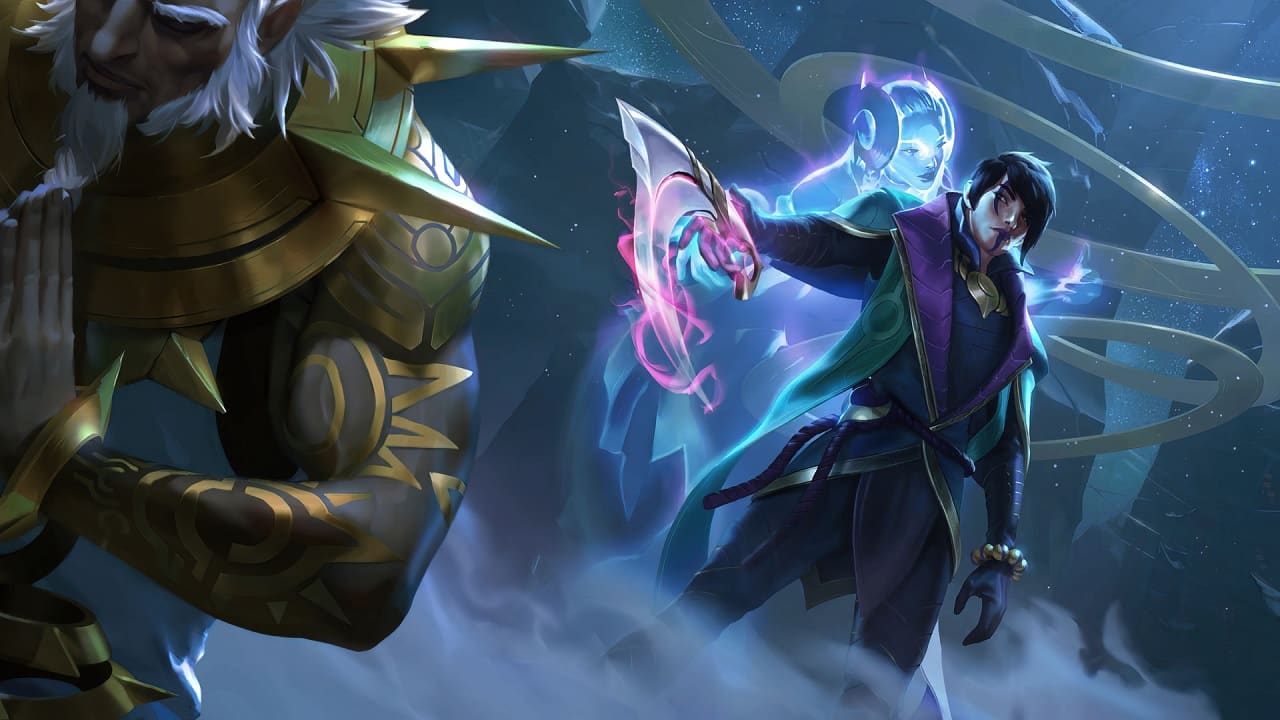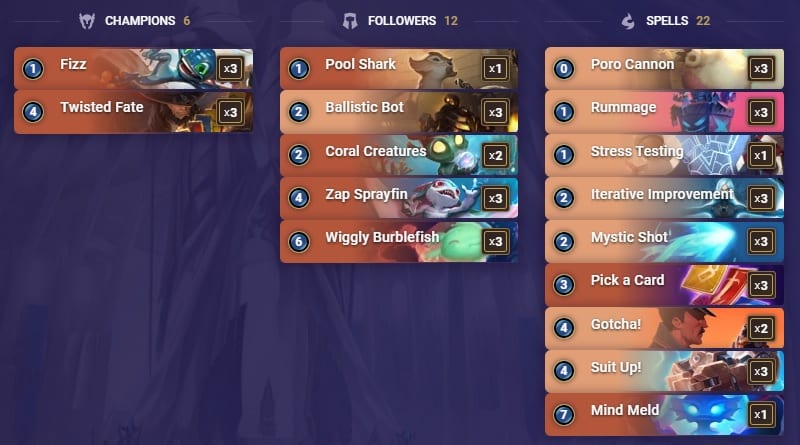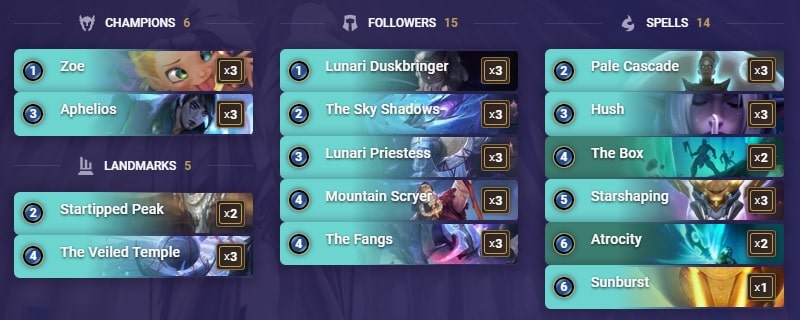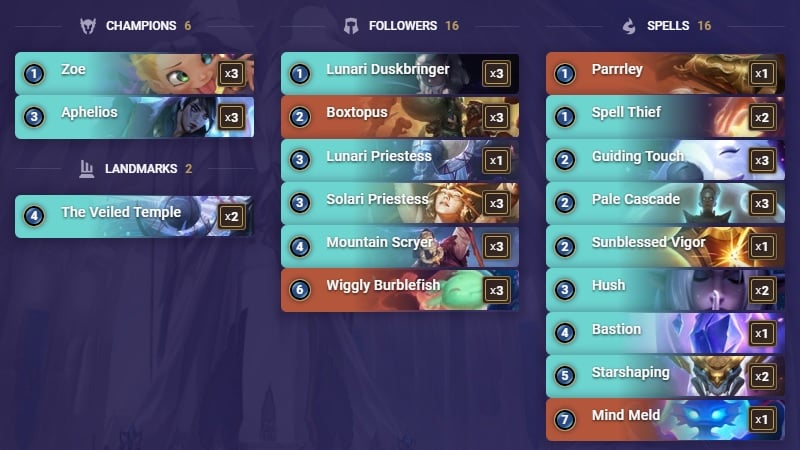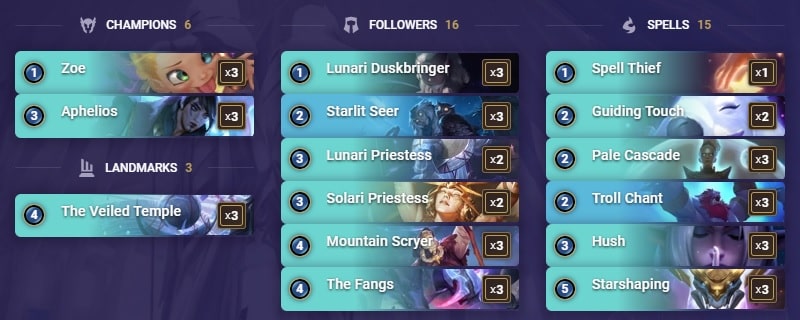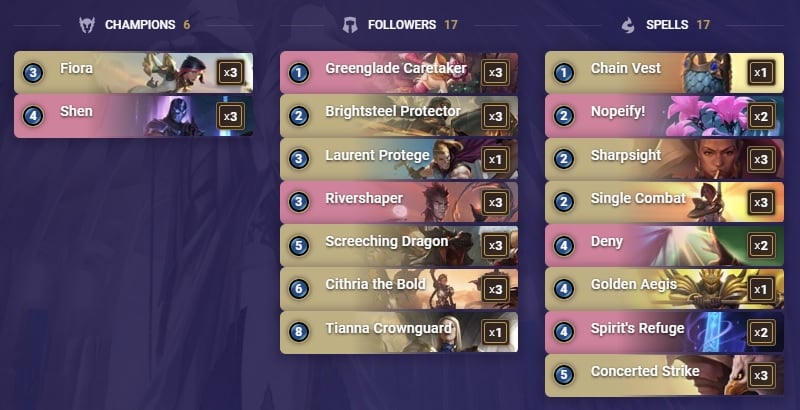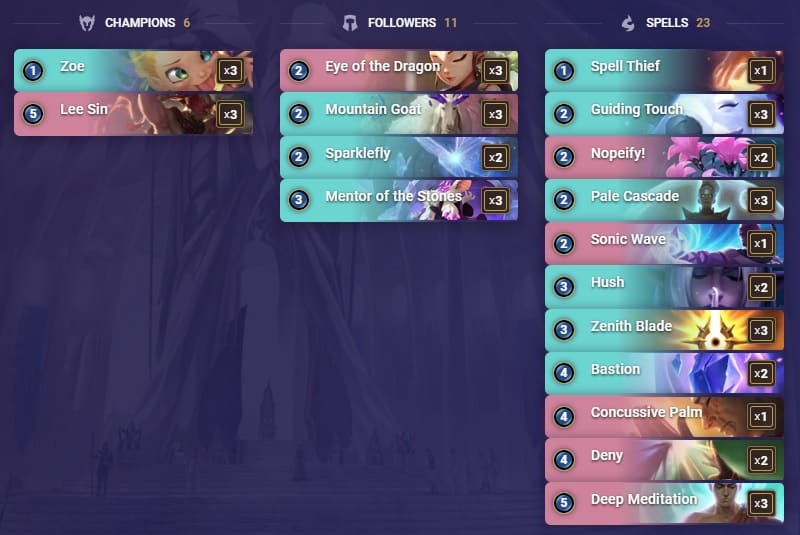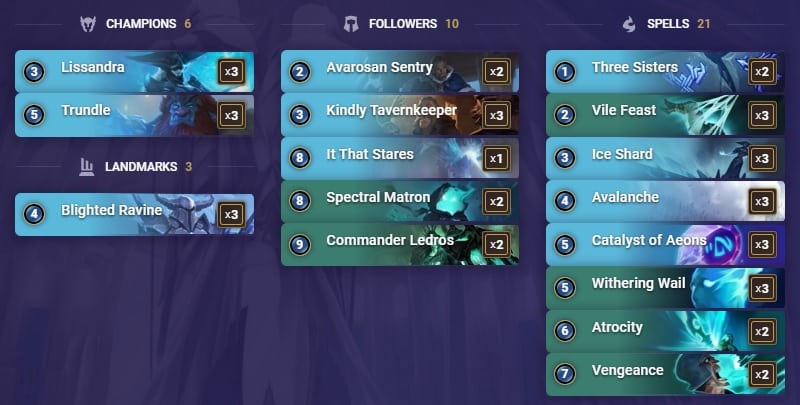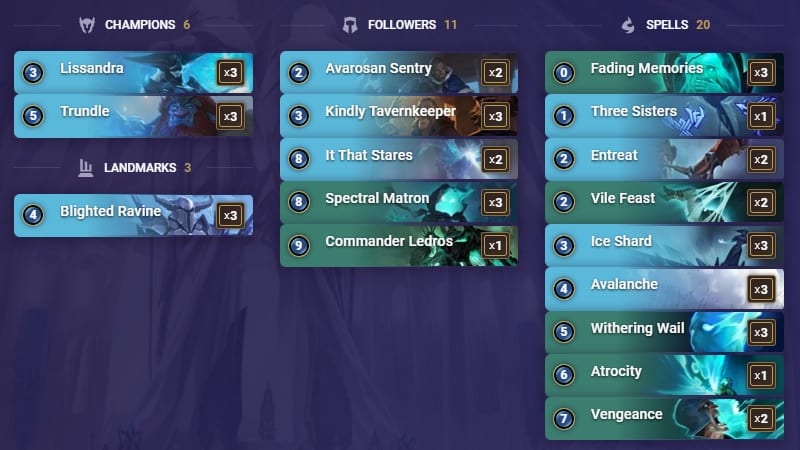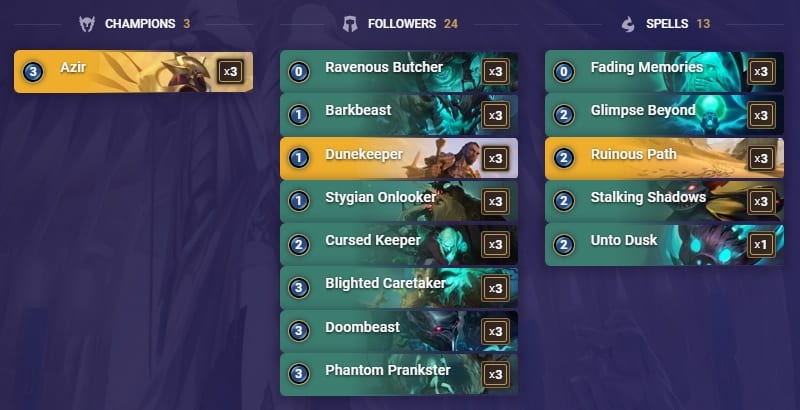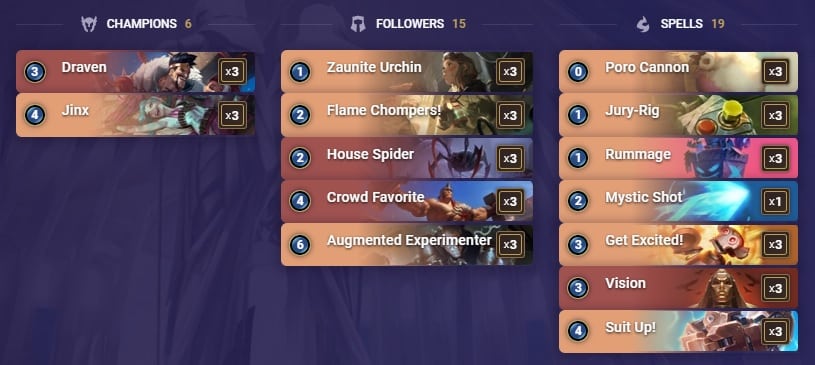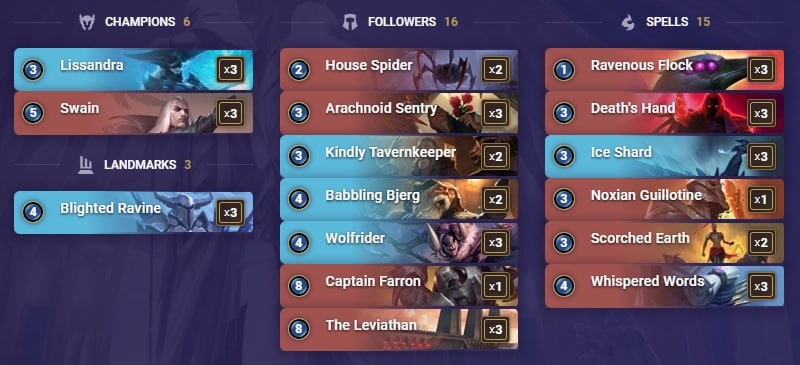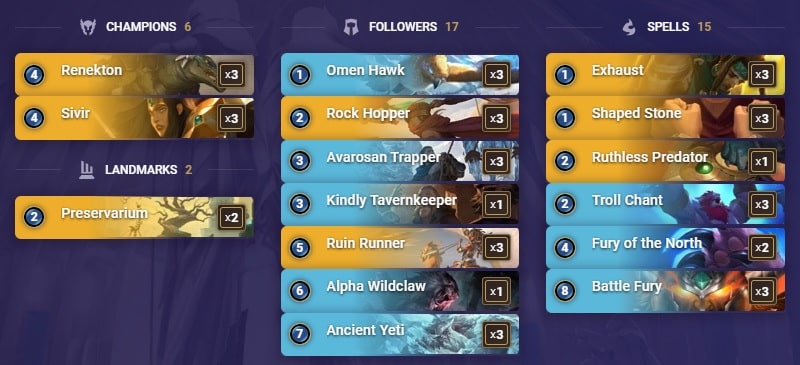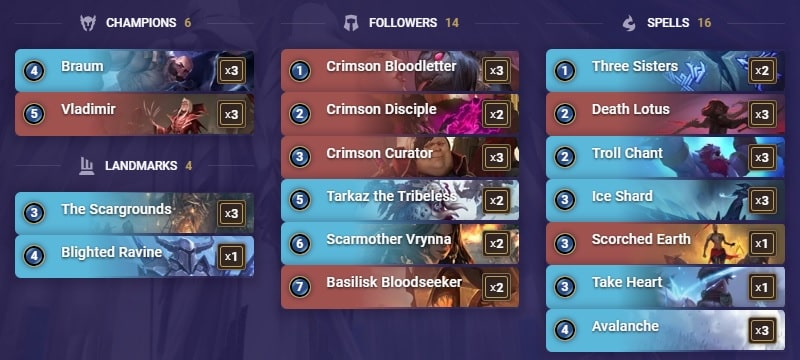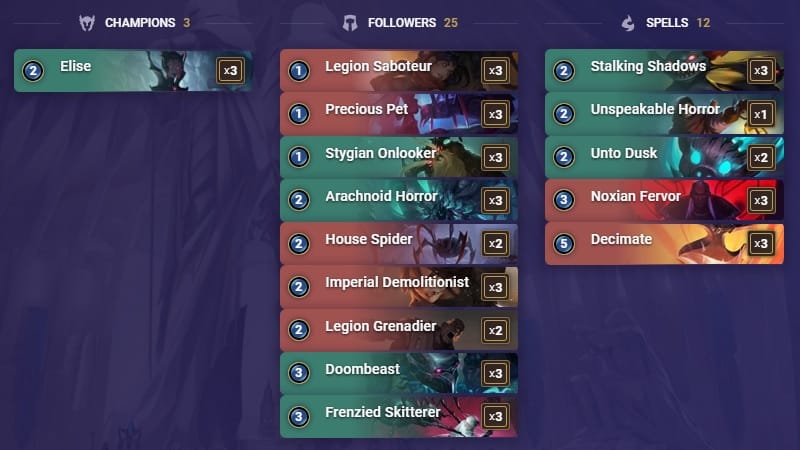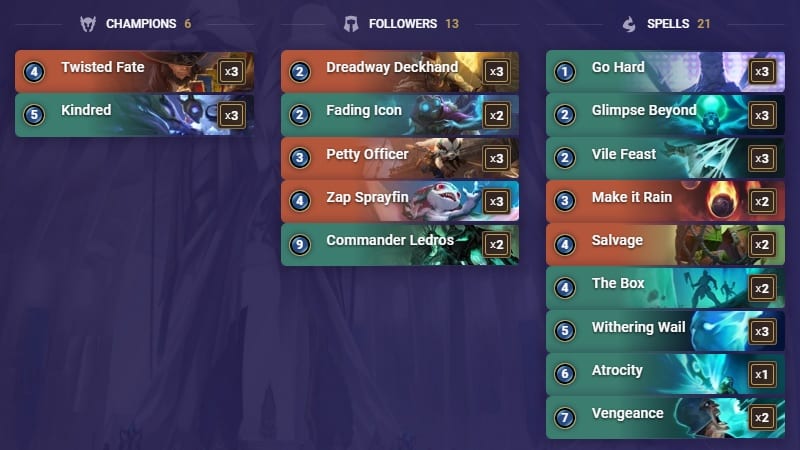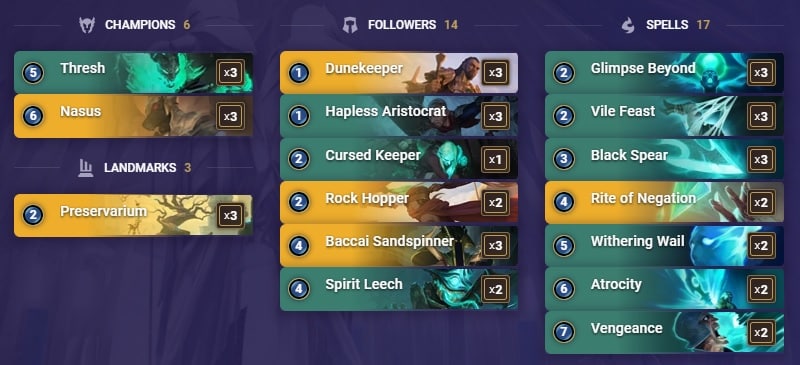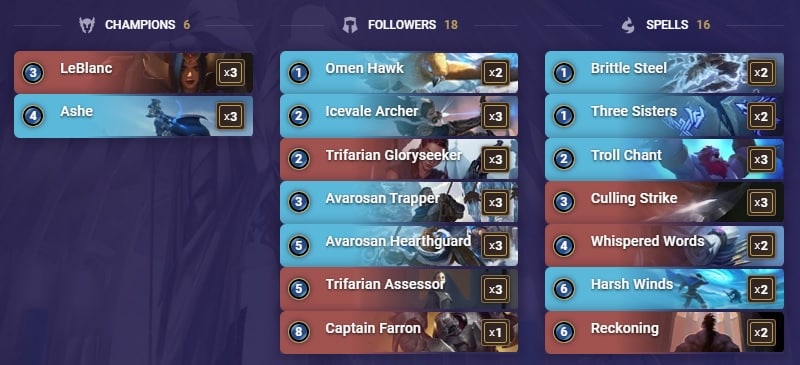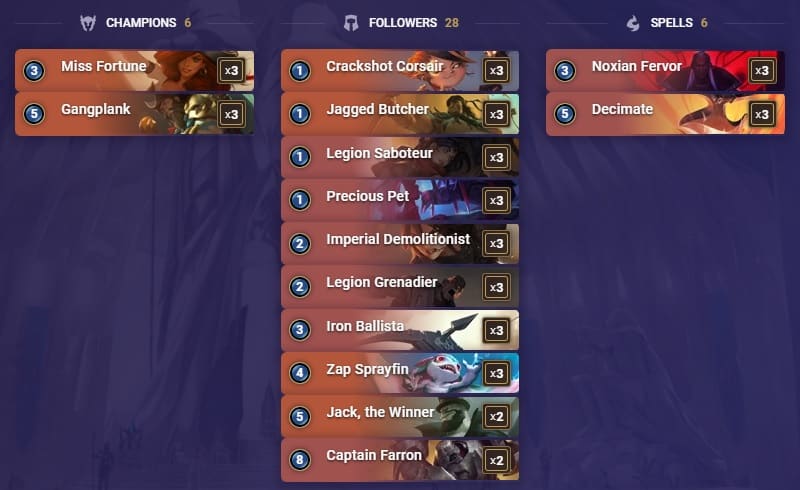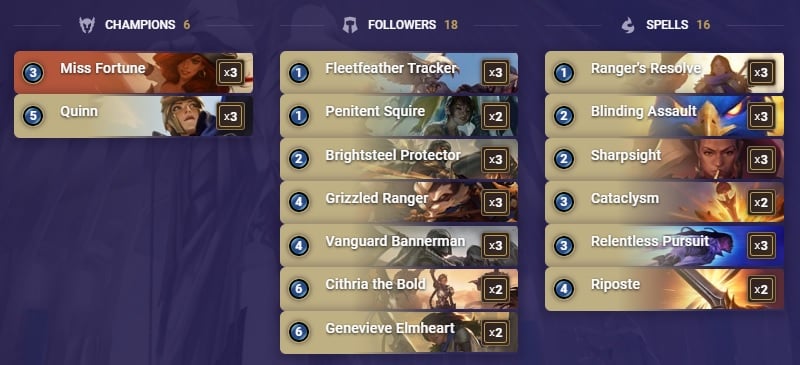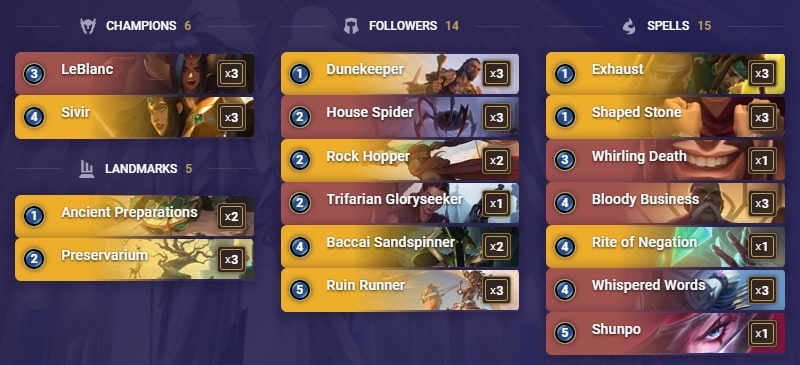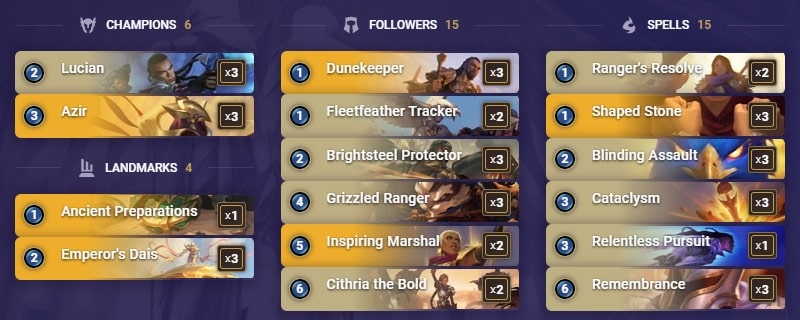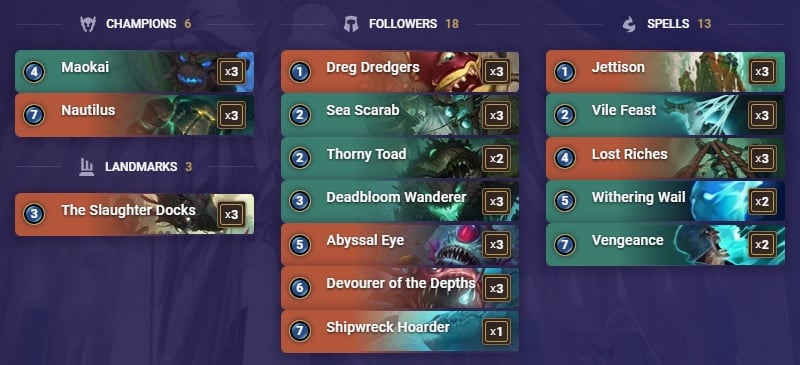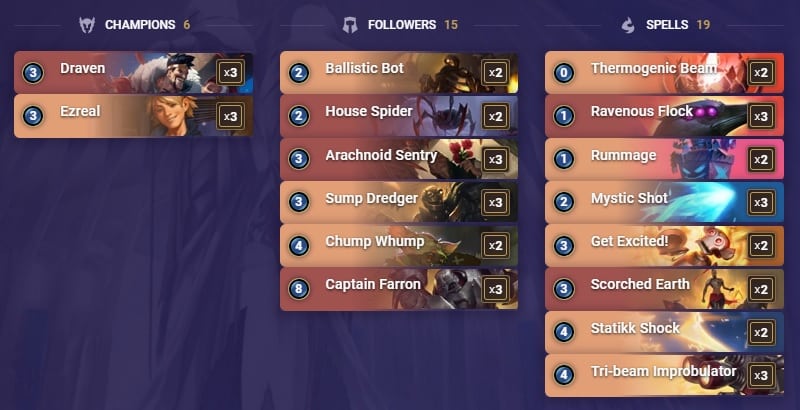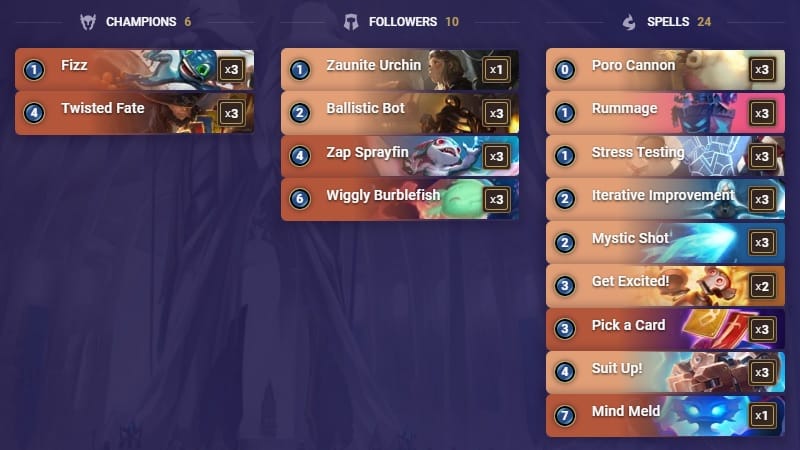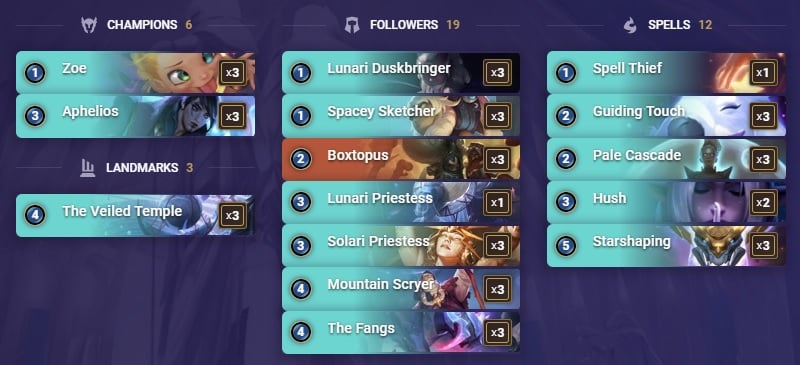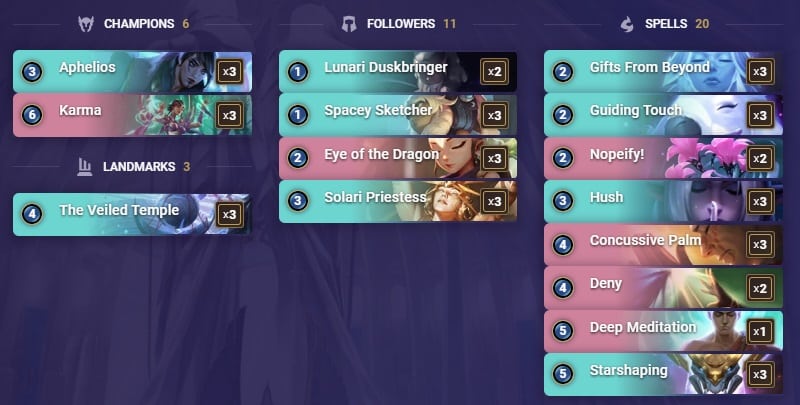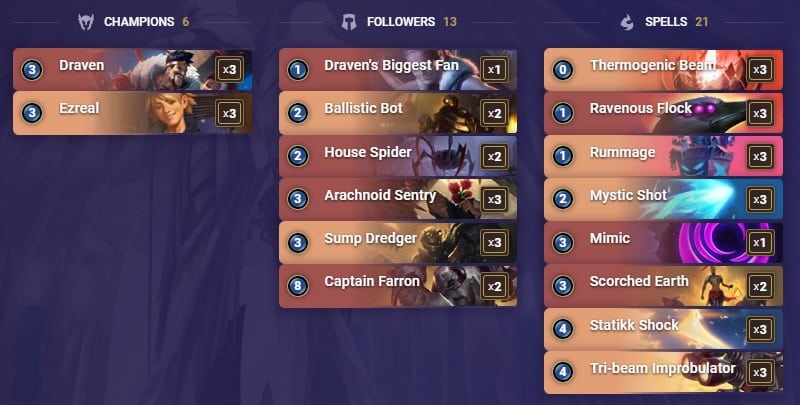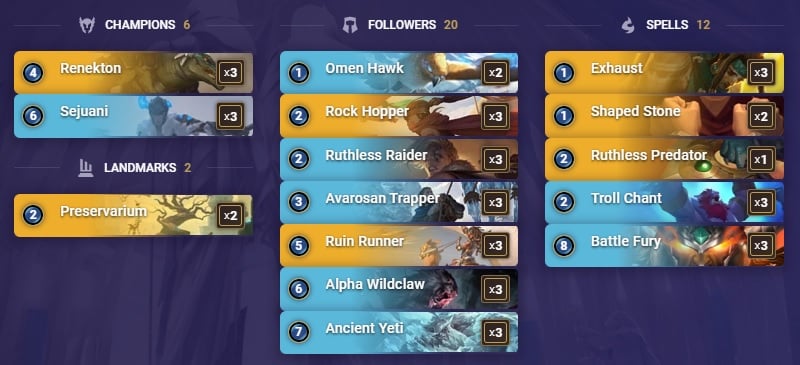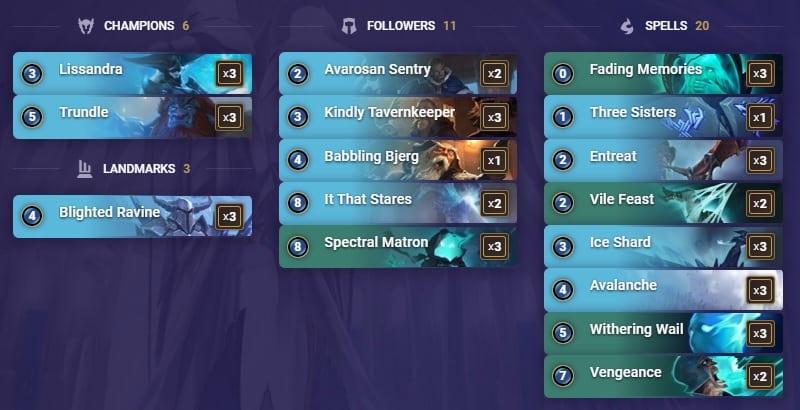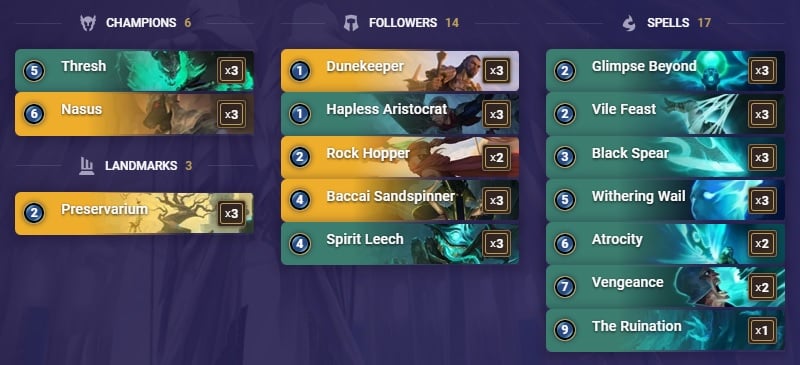Welcome to TLG’s latest meta snapshot for Legends of Runeterra, a series in which we give you our insight on the finest decks in the higher ranks of the ladder.
Every Monday, we discuss the decks that are part of the week’s meta and rate them on a scale of 1 to 5 stars. We also look at the evolution of said decks’ ratings across weeks and draw conclusions regarding the current state of the game, all of this so you can delve into your own ranked journey with a head start.
Since we’re all in anticipation of the upcoming balance patch, we decided to add a modest tournament meta review into the deck spotlight, focusing on three different lineups. Nothing else has changed last week, so enjoy this insight into the mindset of our pro players. We’ll see you next week, where we should have a bit of a shake-up to process for you.
If you have any questions, feel free to drop by our Discord. Best of luck on your climb!
Graphics: WellMax81
Editing: Wusubi, Sebodunum
Writers: Den, Ultraman, Othal

CICQCAQEAMAQGBQRAIAQIAJUAMBQIBINCICAEBQ2EYVS4AQBAIDA4AICAQDAEAIDAQMQEAQGBEVA
The first ever 5 stars in our snapshot had to go to the strongest deck in the history of the game. If I’d told you 2 months ago that Fizz would be part of the best deck we have ever seen, you’d have laughed at me. Yet, here we are. Fizz-TF is crazily unbalanced, being able to cheat the mana system, level-up TF in one turn, make an untargetable Fizz a big 4/4 and never run out of options thanks to the high amount of card draw.
That being said, let’s review the possibilities we have to counter that annoying fish and the card dealer. The Box, Withering Wail, Ice Shard, Avalanche, Blighted Ravine and even Death Lotus! So many options to stop the fish from crushing your Nexus. Wait, what are you saying? Wiggly Burblefish cost nothing? While all the AoE costs mana?!
So they can force the removal out by pushing the boundaries with Fizz-TF as they level-up, the Ballistic Bot eroding your Nexus, then use the Burblefish to kill you in one turn, as you don’t have enough mana to defend yourself?
Well, forget everything I said prior. Play defensively, don’t ever use mana, and if you have to, pray to whatever you believe in that your opponent doesn’t have all of the Burblefish and ways to duplicate them. Slow spells won’t help you if the opponent knows how to play, fast spells can’t deal with the 4/2 Burblefish if you don’t have multiple copies of them.
Your opponent will be able to use up to 6 mana a turn while you’ll be stuck not using 8 to 10 of yours (if your deck even has the required answers). So how to beat Fizz-TF? Be patient and wait until the opponent makes a mistake that you can finally punish. If they don’t make mistakes, they’re going to win the game, and there’s nothing you can do about it. (Write-up by Ultraman)
Shadow Isles splash
CMAQWAYJBERUSS2MKRK5QAOZAHNQDXIBAIAQICIKAIAQKEYZAEAQGCIX
Bilgewater splash
CMBAEAYGA4IQOAYJBERTGSKMMDMQCAIEAMESUVCV3MAQEAQCAYJCUAYDBEJUWYQ
Freljord splash
CMBQCAIBEAAQGAICBEBQSCJDJFGFIVOZAHNQDXIBAEBQGCJTJNQACAIDBEVA
Aphelios is no longer paired with TF in most of the current builds, that distinction goes to Zoe now, forming what’s undoubtedly the most flexible champion pairing the game has to offer. Both champions are from the same region, and both are capable of carrying the game on their back with the absurd amount of value they can generate if they remain well-protected.
This makes Aphelios-Zoe one of the most feared duos on the ladder nowadays. While Fizz-TF is the best deck, Aphelios-Zoe can definitely brag about being the most flexible and unpredictable. The deck has access to a never-ending flow of Celestial cards, two early game champions forcing the opponent to react to them and a low curve which can still play 7-9 mana bombs in the late game. This archetype is the definition of an “all-around deck.”
Proof of this is the amount of splash possibilities we’re currently seeing, as Targon has been paired with SI, Bilgewater and even Frejlord to add the final 3 or 4 cards to the deck. SI looks to be the best combination for now, Atrocity being another card that could be in the discussion for a potential nerf.
It allows the deck to gain access to direct damage to the opposing Nexus, one of the few things Targon isn’t capable of doing. Cards like The Box or Withering Wail can also help against Fizz-TF or Aggro decks for example, in case you wouldn’t feel like the healing capacity was enough.
When you see Bilgewater added to the deck, it’s due to Boxtopus, arguably the best 2-drop to pull with Aphelios’ Crescendum. The region also offers Mind Meld or Pick a Card if you would like to add a finisher or some more card draw to your deck.
While the Freljord splash might appear weaker than the other two, it has its merits. Starlit Seer is strong in this deck, as we’re playing spells each turn. If there’s The Veiled Temple in play, 3 spells will be more common than 1. Having Seer as the 2-drop helps the deck create beefy minions and fight the board much more efficiently.
This can help a ton against Midrange decks trying to beat us in combat. The addition of Troll Chant is another great tool with which to protect our champions or our health against Aggro decks.
For now, Aphelios-Zoe performs like the second best deck on our snapshot. It’s fascinating that Aphelios can perform that well despite being nerfed. It wouldn’t be shocking to see this deck rise to the very top if Fizz-TF is next up on the nerf hammer list. (Write-up by den)

CMCACAQAAEBAGAAGBYBQCAQTEAVQIAIABENC2MYCAEBQEFACAEBCKMICAECAAAQDAEAAECYN
In a brand new environment, being able to rely on evergreen concepts is a major help, and of course this is where Fiora-Shen comes in. Probably still the best pure tempo deck of our top 5, Fiora-Shen is one of the few decks that still aims at winning the game through combat instead of back row synergies.
The small difference now is that, with the arrival of Shurima and much more Vulnerable tags to go around, Shen looks to have grown in importance in the deck, as the Barriers are one of the best ways to prevent a unit from falling prey after gaining the Vulnerable tag.
While the deck didn’t receive a lot of help with the last expansion, one card has found its way into the deck, and it might be a difference-maker. Golden Aegis looks to be miles ahead of Relentless Pursuit in terms of flexibility, as the former can be used in a much wider variety of situations than the latter. One extra mana isn’t always something we want to pay for the card, but the added Barrier effect can be worth the investment.
It allows Fiora to be even scarier and creates more awkward situations for the opponent, who has to decide what takes the hit; the Nexus or a unit. Against control matchups, the card is great as we want to pressure as much as possible, so added attacks are always welcome. The Barrier keyword in this case helps mostly to level-up Shen, who’s the real star in the slower matchups. His +3/+0 bonus to allies with Barrier helps to push for significant Nexus damage.
The meta is much faster than before, so Brightsteel Formation is too slow to stay in the deck. Instead, our favorite angry lady is included: Tianna Crownguard. The deck functions the same way as before against most opponents. The multiple Rally effects are needed to pressure highly-synergistic decks like Lissandra-Trundle or Aphelios-Zoe, which you should encounter frequently.
Still a deck to account for in this new environment, Fiora-Shen looks to be a solid top 5 pick for now, although it still has a clear gap to cover to reach the top. Lovers of tempo gameplay and pressure strategies should find a reliable way to climb the ladder with this deck, which, once again, has found a way to be relevant. (Write-up by den)
CMBAGAQCAMDASBQDBEERWIZJGNOAGAIBAIYQCAYCCQBQGCITFBKQEAIDBEVAEAQCAUEA
Lee Sin is another deck in our snapshot that hasn’t changed much with the Shurima expansion. After a quick digression with the Predict mechanic, the Blind Monk is back with his true ally: the Targon region. The Predict mechanic wasn’t so bad for the archetype, as it allowed the deck to be reliable in accomplishing its combo.
The problem was that the deck didn’t have any flexibility, which is extremely valuable in the current state of the game. As such, pairing Lee Sin with Targon appears to make him more versatile. The addition of Lissandra-Trundle to the meta aids this deck, as Lee Sin feasts on slower strategies that let him set up properly onto the board.
As time goes by and Aggro strategies are shown to not be working so well (at least at the highest level), Zoe-Lee appears to be one of the decks that got better with the Shurima expansion. While Fizz-TF admittedly destroys this deck most of the time with aggression that is too much to handle, the other archetypes give you a bit more room to work with.
Currently, a lot of the other Targon lists are running three copies of Hush, which hurts this deck a lot. Moreover, in overall terms, it seems that Aphelios-Zoe is superior to Zoe-Lee. It doesn’t mean that Lee isn’t a true contender in the current meta, though. What’s more, it could be a great tournament pick, if a control-heavy environment is to be expected. (Write-up by den)
Lissandra-Trundle is one of the newcomers in the top tiers, and since the list is still being discussed, it has led to many hot takes about its cards and interactions. So, which variation is the best? A defensive version, or a combo one?
Defensive version
CMCACAYBAYBACBI5FABQCAIMCQZAGBABAUEQ4AYBAEAQGAIEAEFAIAIFAEMSCLABAEBQCAY
Although we call it “defensive,” most of the time it’s the inclusion of Commander Ledros and Atrocity that ends up preventing the addition of more combo tools, such as Fading Memories. In this variation, Spectral Matron is still played, but Ledros is only kept in as a secondary win condition, so as to not rely entirely on Watcher to obliterate the opponent’s deck.
More AoE, the possibility of accelerating the game and more healing added in the deck certainly makes it more stable, but less destructive. Not having the OTK combo into double Watcher means that the victory won’t be offered to you on a golden plate. Instead, you will have to take it bit by bit, wearing out your opponent until they lack the answer to Ledros, or until you’ve played enough 8+ cost units to finally use your Watcher.
Combo version
CMCACAYBAYBACAIUGIBQCBI5FQXQGBABAUEQ4AYBAMAQGAQBAEBR2AQBAUASQAQBAQAQUAQBAUMSC
The less stable approach drops some of the Ledros/Atrocity tools altogether, meaning there are fewer answers against Aggro opponents and no ramping at all. To compensate these losses, the combo version focuses entirely on playing Watcher as soon as possible, thanks to 3x Spectral Matron and 3x Fading Memories, as well as more 8+ mana cards.
These allow you to duplicate Trundle’s Pillar or Watcher, meaning that even if the opponent can answer the first two Watchers, you still have access to more. You can also duplicate Spectral Matron, as an easy way to level Lissandra in one go and to reduce the cost of Watcher to zero. The aim is to do this rapidly in order to overload the opponent’s capabilities.
This deck also utilizes Entreat, so as to avoid leaving drawing your crucial champions up to chance. Your win condition is way more complicated to set up, but it’s significantly more powerful as a result. That’s the strength of this version: against more control-oriented decks, it will force your opponent into situations from which they simply cannot emerge unscathed, almost guaranteeing a win even if your first couple of Watchers aren’t able to attack.
However, the combo variation will find facing Aggro decks rather tough sledding, as Fading Memories are pretty lacklustre in those matchups and the plethora of 8+ cost cards along with fewer AoE spells leaves you very vulnerable to being punished by Midrange decks, let alone hyper-aggressive ones.
Conclusion: For now, I will abstain from making a hot take myself. I think both versions have their own merits and should be used respectively based on your own playstyle and preference, also depending on what you tend to run into the most in your geographic region and at your rank.
Being defensive is great against aggressive decks, such as Azir Burn, Discard Aggro, Pirates and Fizz-TF, but the combo version is better for mirrors, Fiora-Shen, Lee Sin and Aphelios archetypes. Pick your (icy) poison! (Write-up by Ultraman)

CMCAEAQFAQDAGAYFAMCAMAYEA4BRUUQFAECQWJRPGAYQAAIBAQCQW
Every meta has a damage-based deck that punishes anyone who forgets to play in the early game. In the Shurima patch, that deck is Azir Burn. With a straightforward game plan and a Slay-based explosive start, it’s capable of dealing a ton of damage early on before attempting to finish off with direct damage.
However, the deck isn’t just a one-trick pony. It excels at punishing decks that would leave it alone and it’s great at keeping a high damage flow for a long period of time, making significant healing the only reliable option against it.
The small units in the deck are what make it flexible, as they deal damage early and later on help blocking the opponent while we drain their Nexus with Doombeast, Phantom Prankster and the many cards we have to support them. Crucially, these two cards will help deal direct damage even if the board is lost and our attack turns are worthless.
Given the high amount of draw the deck is packing, trying to outlast it like most decks attempt to do against Aggro strategies isn’t the best way to go about it. While the deck should lose some potential over time, it’s already facing erosion in the meta due to the increasing prevalence of healing (e.g. Aphelios decks, Fiora-Shen and Lissandra-Trundle all have some form of it).
Tier 2 decks can still be pounced on and outpaced as more board-centric decks should give us enough time to set up enough damage to close out the game before they can kill us with their units. The gameplay of this archetype might take a little bit of time to grasp, as the general concept isn’t to deal as much damage as possible, but try to put your opponent to 0.
This is more subtle a nuance than it might appear. If you go for the maximum damage output each turn, you also become very predictable for your opponent, who can focus on solely defending and wait for you to draw until they can be more aggressive. Instead, try to keep a regular damage flow and go for the kill when you’re sure it will actually result in a win.
That patience aspect is what makes the deck really scary, as the opponent will usually assume a defensive stance against you, giving you the time you need to set up properly and plan ahead for even more potential damage. Once you have this mastered, you’re ready to be a real terror on the ladder. (Write-up by den)
CMCACAQEAMAQGBASAQAQGCIUE43QOAIEAEGA2HBHFAWQAAIBAECDI
Similarly to Fiora-Shen, Discard Aggro is a deck that doesn’t change much from one meta to another, but then again, it doesn’t really need to. I consider this deck to be the gatekeeper of good decks in the current format. If you can’t handle Discard Aggro properly, you probably won’t have a good time against the other decks.
While the deck is capable of some insane high-rolls and could OTK someone on Turn 4, it’s also fairly predictable if you have the tools to deal with it. Although the deck has stayed basically the same, the meta being centered around slow decks helps it a lot.
Amazingly, I managed to maintain a positive winrate vs Lissandra-Trundle on my way to Masters with the deck, showing that even this control-packed deck more often than not didn’t have the answers to counter a heavy dose of early game aggression.
Suit up! is also a decent card to play around AoE and a leveled Jinx is a pain to remove for a lot of decks at the moment, so she’s free to generate a ton of value with her Super Mega Death Rockets turn after turn. I personally think the archetype still deserves the title of the best Aggro deck in the game, and its capacity to flood the board and present different levels of threats should be treated with respect. However, the aggressive decks as a whole aren’t looking so good right now.
Even if on paper, the top 5 decks should almost only be favorable matchups (although Fiora-Shen is incredibly hard to beat), the capacity of these decks to generate cards and get out of situations through healing or sheer value is incredible. As such, Discard Aggro feels like a really good deck, but one that can’t really consistently keep up with the big boys. Having no new cards to feed into the deck adds to this feeling.
Still a solid pick to climb the ladder, Discard Aggro can be regarded as a “quantity first” deck, whereas the best decks on our snapshot opt for the “quality” approach. It sounds like good news that the aggressive decks aren’t out of the picture though, and if decks keep on trying to be greedy, Discard Aggro could get even better matchups with time. (Write-up by den)
CMCQCAIDFYAQEAIJAECAGAQDAQAQKCIOAQBAGAIHBAEQGAIBAM3QCAYDBUBACAIHGIAQEAIDCYZQ
Swain’s back, and he has found a new and improved ally in Lissandra, who can give him access to an excellent stun and some damage on her level-up.
On top of this, the fact that she has a decent statline and a potential to eventually spawn an 8/8 with Overwhelm makes her an excellent partner for Swain. Multiple AoE spells help with Swain’s level-up, which he obtains easily by Turn 5 almost every game, pressuring the opponent while also handling aggression in the early turns.
Ice Shard and Blighted Ravine give your leveled-up Swain free stuns by hitting the opponent’s Nexus at the start of the turn, forcing the opponent into either having a removal spell or a 3+ strength unit with more than 2 health on the board in order to stop the mighty strategist from hitting their Nexus too hard.
For obvious reasons, we are fans of The Leviathan card. Its synergy with Swain is often a game over message for your opponent, and the multiple draws of the deck makes it virtually certain to find your war ships in every game.
Finally, something that’s a Noxian tradition at this point: if the game is going dreadfully, just find your Captain Farron for an exit doorway right into the steal of your life. 8 damage to face plus two Decimates in hand ain’t no joke and multiple decks won’t be able to find the heal necessary to survive. (Write-up by Ultraman)
CMBQCAYBAICACAIFCYPTABQEA4KCMLJXINOQEAICAEDQCBAHBUBACBAHIUBACAI2GI
Most of the Overwhelm lists I see online feature Renekton and Sejuani, which makes sense as Sejuani applies a Vulnerable tag that Renekton can use to grow when attacking. My issue with this, however, is that most of the top decks in our snapshot aren’t exactly board-oriented and Turn 6 is rather distant when we look at the currently popular strategies.
Thus, I chose to adopt a faster version of the Overwhelm archetype, which includes Sivir alongside the terrifying crocodile. She’s great at using the Vulnerable tag as well, since she has Quick Attack, while her Spellshield makes it very difficult to remove her, even for a control deck.
In essence, Renekton-Sivir is a pressure deck, where you should aim to develop their board before unleashing a ton of damage on their opponent. While control matchups are straightforward, as the board is almost given to us for free, it’s the board-centric matchups that can be more complicated to navigate.
Those will require a great vision of how things can develop on figuring out how to trade and when to flip the switch and try to seal the deal. As a rule of thumb, I’d say Sivir is the control matchup champion and Renekton is the board matchup champion. So make sure you support the right one depending on the opponent that’s in front of you.
Recognizing that decks like Fizz-TF and Lissandra-Trundle will be prevalent in the meta, I think this deck should be built to aim at killing your opponent no later than Turn 7 or 8 (depending on if you attack on odd or even turns), otherwise you will likely get comboed out of the game - and there’s nothing you can do about it with this deck.
This is the reason why the deck is playing triple Battle Fury and doesn’t feature expensive units that we wouldn’t have time to develop in most games anyway. The idea is to dominate from Turns 3-4 to Turns 6-7, before delivering the killing blow with a timely Battle Fury. Against decks that you know cannot pull any trickery and will fight you on the board, a slower approach is also possible, especially with Ancient Yeti in hand.
Take good trades, use spells to protect your important units and build a board that the opponent can’t do anything about. In a lot of scenarios, dealing 20 damage at once is possible. Overwhelm looks to be in a good spot in the current meta, the problem comes from the other top decks that have reached an incredible power level, to the point where you cannot do much about it.
I’d advise playing around what you can when planning how to put your opponent on edge, but keep in mind that most of our top 5 decks will beat you with the perfect hand, no matter what you do. I still recommend this deck to climb with, though, for those who like board-centric gameplay and beefy units. There’s certainly something to be said for the pleasant feeling you get when you hit your opponent with a 15+ attack unit in the face. (Write-up by den)
CECQCBADCIAQIAIJAIAQCCIUAIBQCAQUAMAQGBRQGICACAIDDYAQGAYRAECACCQCAEAQ2FIDAEAQCLQBAQAQ4AIDAMGQ
Noxus and Frejlord are usually paired in the Frostbite archetype, and its most recent iteration, LeBlanc-Ashe, has gained some popularity over the last few weeks. But the deck at the forefront of this regional pairing lately is Vladimir-Braum, a list that has been sighted popping occasionally since the release of its foundational landmark: The Scargrounds.
With the last expansion, this deck received a lot of help. Cards like Ice Shard, Blighted Ravine and Crimson Bloodletter became staples in the list almost immediately. For now, it doesn’t look like a clear 40 card deck has clearly emerged as the best list for the deck. This doesn’t mean the pairing of these two champions can’t make strides, as the deck is being played by many high profile ladder players in the community.
The concepts behind the archetype are simple: get The Scargrounds down and then abuse the Tough keyword to protect your minions while buffing them to absurd amounts of attack points. The best part of this plan is that it works almost the same way whether you’re trying to be aggressive or defensive, as cards like Death Lotus, Ice Shard or even Avalanche can simultaneously destroy the opponent’s aggressive game plan while serving as a mass enabler for our board to push a ton of damage.
With good matchups vs most Aggro decks and the capacity to pressure damage-based defensive decks like Lissandra-Trundle, this appears to be a deck that could be a possible “meta breaker.” It could represent a decent Midrange strategy that’s actually capable of flexibility instead of solely focusing on developing the board and pressuring the opponent.
This initial impression may be coloured by the deck benefitting from being somewhat unknown and opponents consequently not playing optimally against it. Yet, Freljord/Noxus seems to be on the rise. Last week it was Lissandra-Swain, this week that distinction definitely goes to Vladimir-Braum. Since the deck hasn’t even been fully optimized yet, it seems the only way is up for it at the moment. (Write-up by den)
CMCAEAQDAMCAGAIDAIHSQAYBAUTTKOADAMCQGBAGAIAQIBILAIAQGJJXAEAQGBIC
Aggressive decks have returned lately, as the current top tier lists are too flexible to try and counter them with a slow approach. As such, we have seen decks like Discard Aggro, Pirates and Azir Burn rise in popularity in order to pressure Fizz-TF early and prevent it from easily developing.
While those mentioned decks have been in the meta for weeks now, Elise and her spiders have been a much quieter presence, lying in wait for their time to emerge once more. As probably the fastest aggressive deck if left unchecked, this isn’t the kind of deck that can have much staying power in terms of popularity. This is because it’s fairly easy to counter.
Instead, this deck is to be used when it can feast on non-reactive decks, trying to play their strategy and force the opponent to answer it. Well, spiders don’t (and can’t) answer to anyone (except maybe Elise). They aim to set up quickly (e.g. Precious Pet into Elise) and get in an absurd amount of damage when the opponent can’t respond in the first few turns.
With a 20 health Nexus, this deck can kill you as soon as Turn 3 if everything goes its way, and usually aims to win on Turn 5 or 6 if it was slowed down. While it’s a predictable deck that can be countered easily with cheap AoE and healing, the current meta doesn’t really feature these kinds of tools frequently.
Lissandra-Trundle keeps losing popularity over time, as Fizz-TF players are adapting to the matchup, and board-centric decks are switching to a more damage-centric approach. This leads to a perfect environment for Elise Burn, a deck that’s very happy to take on a race against anyone, considering it basically starts the race at lightning speed from Turn 1.
The deck needs the surprise element to be successful. If it keeps on gaining in popularity, we might see some defensive decks come back, which would be a huge punishment for it. With a patch on the horizon for this week too, spiders might lose their best matchup and go back to being a surprise pick.
Until then, if you like super aggressive, pedal-to-the-metal strategies, you might be able to cheese some wins with what is the king of face damage for this week. (Write-up by den)
CMCACAYFCAAQIBIFAMAQKHJIGECAEBQEBANCMAYBAQCQGAQCAYOS2AYBAUARGIIBAEAQKGI
The addition of Kindred to the original mix had to be met with some adjustments, slowing down the deck a bit, following the Pack Your Bags nerf that did quite a bit of damage to the formerly aggressive playstyle of Go Hard.
No more do we have Ravenous Butcher and Elise, we’re now a full fledged anti-Aggro list with even more draws and removals for bigger, stronger minions. TF and Withering Wail do wonders against most aggressive decks nowadays, be it Azir and his Sand Soldiers or Fizz and his army of jellyfish.
Compared to many of the top tier decks, Go Hard lacks a way to cheat the mana system, so losing control over a situation will quickly snowball into you losing the game. Your comeback potential is dependent on Pack Your Bags meeting no opposition, or a leveled-up TF destroying the board turn by turn, until even the opponent’s Nexus disappears.
Kindred benefits from you killing your own units to draw, but will most of the time require a full turn of mana to be played out to make an impact. Thus, she mainly works to consolidate your advantage once you’re dominating the opponent - don’t expect her to shift the game in your favour on her own.
She also does wonders against decks with few to no ways to answer the card. Furthermore, Kindred ensures that you aren’t too disappointed to topdeck small minions in the late game, as these can be sacrificed to her benefit. (Write-up by Ultraman)

CMBAIBAHBUNC6UIFAECSEKBLGE2AGAIEAUIAEBAHEY5QGAIFAEMR2AIBAECTA
This is a slower version, with multiple control tools layered around a powerful core of drawing mechanics and Thresh. With so many removals, Thresh will level-up rapidly, allowing you to “let the dogs out” as soon as Turn 7 most of the time!
The removals also help with stacking Nasus, making him grow big and strong enough that your opponents will struggle to find answers for him. Your low mana minions can handle early game aggression while also serving as tokens for the suicide mission. This allows you to keep a full hand with many options while also activating some cards, such as Black Spear.
If some of your low mana minions are on the board when Thresh comes in play, they’ll now act in a triple role of a) keeping the opponent in check while pressuring them with damage, b) Thresh stops them from using AoE and trades to get rid of them and c) at the same time, they get used one by one for drawing purposes.
Finally, a decent-sized Nasus hitting anything will often result in him leveling-up, and that Spellshield obviously works wonders with Atrocity, allowing you to hit a surprise lethal. This is especially strong given that you now have access to Rite of Negation. (Write-up by Ultraman)
CMCACAYBAIAQIAYEAMAQGBA7EECACAILEYUTABABAEBTKAIEAEFACBADAIBQCAIWDYVACAIBAMZQ
LeBlanc is still a debatable inclusion in the current meta, as her 2 health makes her feel very weak to any Piltover or Freljord deck running Mystic Shot or Avalanche. Against other board-centric decks though, which don’t run spells but instead rely on combat to control the board, LeBlanc-Ashe can definitely make an impact as a pairing.
It has to be said that Frosbite wasn’t doing so well last month, and we aren’t expecting this archetype to make a comeback as a top 5 deck anytime soon. The showcased list was used by Taytwo, who reached Masters with a 60% winrate. According to him, Reckoning is the card that makes the deck function.
With most decks being centered around low-cost minions and very synergistic approaches, it’s fairly rare that a unit will reach the 5 attack mark in most of the current best decks. Having access to such a good removal tool gives the deck enough time to develop the board and pressure the opponent. Being able to kill Aphelios or TF when they hit the board with Culling Strike is another reason the deck can be a real contender.
Against other board-centric decks, the Freeze package and two attack-focused champions give this deck every chance to be winning a trading battle, which usually will end up with Ashe naturally evolving and taking over the game. Keeping LeBlanc safe on the back row while she generates Mirror Image also is a valid possibility if we’re in no rush to close the game.
Most minions in this deck have a lot of upsides to be copied and contribute to building a solid edge over time, which we can capitalize on later. Frostbite doesn’t look like a deck that will take the ladder by storm, but Noxus appears to be a great region currently, as it allows the player to both pressure and answer the game plan of popular champions. (Write-up by den)
CMBQGAQDAMCAKBABAMBA6JJIAUBAMFRAEY5DYAQBAEBTGAIDAYDAA
After seeing their colleague TF dominate the meta, Gangplank and Miss Fortune decided they wanted their spot back in the snapshot. Being polite and giving everyone a chance is important to us, so we obliged them.
Pirates have always been a staple of the ladder for simple reasons: it’s easy to play and can be adapted by changing a few cards for personal preference or to try and target certain matchups. The main goal is to push reliable damage to the opposing Nexus with low-cost units such as Crackshot Corsair or Legion Saboteur, with the possibility of doing this even during your opponent’s turn by trading your Legion Grenadier or playing Imperial Demolitionist to speed up GP’s level-up.
Then, when your opponent’s Nexus is quite tender, push the remaining damage with Noxian Fervor, Decimate or the notorious Captain Farron - who remains a huge threat even following his nerf. You will most likely have to take hits so as to avoid losing pressure potential and tempo, but that’s not a big issue.
You don’t necessarily care about board domination, more so about pure aggression: almost all of your cards are made to Burn down the opposing Nexus, and non-Aggro decks will be hard-pressed to keep up with your speed. Don’t hesitate to push some damage in by attacking with relatively precious units such as MF or Crackshot Corsair, as their attack might be the difference between a win or loss in the end.
But this deck isn’t one of the top dogs for a good reason: you will burn through your resources quickly and your gameplan is very predictable. If your opponent is able to read you or counter your early game, you will find yourself out of juice and unable to finish the game. Pirates lack the bench threats (e.g. Jinx), card draw and the flexibility of some superior Aggro archetypes, like Discard Aggro. (Write-up by Othal)
CMCACAQGCYAQGAAOAQAQAAIJCUOQIAQAAIDAOCIDAEBAACQCAEACKMYCAQAAGBYA
Quinn and MF have always worked remarkably well together due to the synergy of their level-up conditions, and there’s been a variation of Scouts in every meta I can remember. Similarly to Pirates Aggro, this deck is easy to pilot and allows for fast games, whether you win or lose.
Your aim is simple: board domination. Not only will you be able to flood the board with followers, the Demacia toolkit will also ensure you get to dictate the trades and protect your key units with combat tricks while getting to your opponent’s threats with your numerous Challenger units. While Aggro decks are usually vulnerable to removals like Withering Wail or Avalanche, Ranger’s Resolve and Vanguard Bannerman will help you bulk up your units to keep up the pressure.
Cataclysm synergizes well with your champions and Scouts, as it serves multiple purposes: it gives you the attack token back during the opponent’s turn if you target one of your Scouts, it helps your champions level-up, and it gives Challenger to one of your units for when you really need to remove something from the enemy board - or if you want to pick on the weakest unit to make sure your Scout stays alive for another attack.
Cithria the Bold and Genevieve Elmheart are both efficient game-ending tools who will allow you to go for a final strike on the opponent’s Nexus. You will also need to keep in mind that this deck is attack-focused: your champions and threats both rely on having the attack token, and without it - or any tool to get it like Relentless Pursuit or Cataclysm - you won’t be able to do much except for building your board for an open attack... which makes you predictable.
All of this will rely on you being able to keep your units alive: the deck’s only source of direct damage is Miss Fortune and even she needs some units to attack and proc her skill. You need to keep the pressure up on your opponent and make sure you’re the one overwhelming them with units and not the other way around. If your board is lost, well, it’s likely the game will be too. (Write-up by Othal)
CMBQCAIDG4BQIAYCAQHQMBAHBUKBULJXLUAQGBAHDQTFCAQBAQDTWAYBAMFR6OA
Until recently, we thought that the male ego was the most fragile thing on Earth, but this deck... This deck created a whole new ranking system for that. Although very aggressive, your minions have so little health that every spell will easily deal with them. Boosts in your possession will help you get some damage in, but you empty your hand so quickly that refilling it will be difficult.
When you don’t have Reputation activated, they will be an insane cost in mana and tempo. So, why does this deck even exist, if it’s so fragile? Well, Sivir and Ruin Runner offer you alternative options that can actually survive both a trade and a spell.
These alternatives will be your base for boosts, and most fast spells that you want to use to trade with your opponent’s threats. It will also help you activate Reputation, and then, finally, all of your cards become dangerous for your opponent. Unlike before, you can refill your hand often and deal damage or force bad trades on the opponent each and every turn.
Your resistance to aggression is weak, although Dunekeeper and House Spider help you greatly in delaying the damage output of your opponent. Navigate that fine line between dealing damage and not having all your minions dying as you drop them on the board - if you do it right, you will win if the opponent lacks a way to remove that pesky Spellshield! (Write-up by Ultraman)

CECAIBAHAMNDGXICAIAAECIDAEAASFRBAECAAAYDAIAQAHJTAEBAABYBAQDTSAQBAQDRYAIBAAKQ
Despite being popular in the first few days of the expansion, Azir-Lucian has since lost a lot of momentum. When compared to the feared The Grand Plaza archetype that Miss Fortune and Quinn formed, it looks like this deck might follow the same route of the other Plaza deck: Lucian-Hecarim.
In a similar fashion to the deck we’re comparing it with, Azir-Lucian can bulldoze its way to victory, leaving no chance for your opponent who can only do so much against the army of cheap minions. Lucian and Azir are both perfect in the deck, making the various synergies stronger while gaining a direct advantage from it.
Lucian acts as the immediate threat that the opponent has to remove to prevent themselves getting overwhelmed with board pressure and multiple attacks each turn, while Azir is a long term investment, keeping the deck relevant as the game goes on.
But the downfall of Lucian-Hecarim came from its unilateral nature, being able to only produce pressure through the board and having limited ways to interact with the opponent outside of its attack turns. This leaves the deck with a very predictable game plan, and experienced opponents will know exactly how to punish you, if given the tools to do so.
While raw power can be a good thing, the current meta is dominated by very flexible decks. These can orientate the game to leverage a good position into a winning one. As good as Azir-Lucian is at what it does, the deck doesn’t give the pilot enough room to manoeuvre and thus isn’t flexible enough to be relied on at the highest ranks.
It gives the opponent a way out if they know how to approach the matchup, which makes it easier to punish the higher up the ranks you go. For those reasons, we can’t consider this deck to be a reliable pick to climb the ladder once past a certain point.
The deck performs quite well in the lower ranks, though, as players there don’t necessarily plan ahead of time and may not have mastered the fundamentals of the game. This is also true for the Azir-Hecarim deck, which is basically the other half of the split Lucian-Hecarim archetype from the previous meta. (Write-up by den)
CEDACBAFB4AQCBJIAEBQMAIBAQDAQAQCAUEAUBICAYSSYLZVHABACAQFA4BACBIBDUAQCAQGDY
Deep is a deck that has always been around, but has never truly threatened to reach the top of the tier lists. With the Shurima expansion, the archetype gained a pretty interesting duo of cards with the Sea Scarab and Lost Riches. Both cards fit very well into the list, the former helps with reaching the Deep status and the latter rewards you for a thinned deck, as you will draw the treasures consistently.
With these additions on top of some good foundations from older cards like The Slaughter Docks, the deck was expected to be back on the map. However, the expectation that Deep will see a resurgence seems to arise every expansion, and each time it fails to deliver on this and propel itself into a potent deck.
The first thing to note is that defending in Legends of Runeterra isn’t an easy task when we see the power level of tempo decks. Decks like Fizz-TF, Fiora-Shen or Aphelios can be extremely difficult to contain because of the sheer amount of pressure they can create. Unlike Lissandra-Trundle, which can win the game with a combo and go from a defensive position to a winning one very quickly, Deep needs more time for that transition to take place.
Currently, the game is in a pressure-packed state, which doesn’t really give Deep this necessary time. As such, Deep is stuck as an anti-control deck which takes advantage of a slow meta when the situation calls for it, something that’s getting rare lately.
In essence, Deep is a classic case of a good deck in the wrong meta. As an archetype, it can be seen as having a good synergy and therefore ready to take into battle. Unfortunately, there aren’t many battles where it looks likely to emerge from the depths with a win. This means Nautilus and his flurry of Sea Monsters might have to be a bit more patient before assuming their place as a serious contender. (Write-up by den)
CECACAYECEAQEAYJAMAQIJBGGQBQCAYUFYZQIAIBAM3QCAYDBUAQGBAFAUAQIAI3D4TTUAA
Once seen as a contender for the top spot in the game, Ezreal-Draven has vanished after the Shurima expansion. The archetype didn’t become bad all of a sudden, but this is a textbook case of a deck not fitting the meta anymore.
Ezreal-Draven is a deck that relies on continuous tempo, controlling the opponent’s resources throughout the game and then relying on Captain Farron or Ezreal to seal the deal by focusing on damaging the opposing Nexus. With Fizz-TF’s emergence, Aphelios’ release and the overall draw capacity of decks being increased, the resource management aspect is essentially gone for this deck.
Moreover, Targon has established itself as the best region in the game, as it features both plentiful healing and card generation, both of which are soft counters to this deck’s strategy. On the other side of the spectrum, aggressive decks, which weren’t such bad matchups before, have become much better at dealing direct damage. This means that another strength of Ezreal-Draven (clearing boards with spells) has also lost some overall power in the current environment.
While looking at it without going into details, the deck could still have some merit and arguably be playable at multiple levels. When being more cautious though, we can see that several of its former strengths just don’t work too well in the current meta.
Trust me, it hurts to rank Ezreal-Draven so low, and fans of the deck shouldn’t necessarily drop it entirely, as there are still good matchups around. It’s just that out-tempoing an opponent or making Captain Farron connect with your opponent’s face isn’t so easy to do anymore. (Write-up by den)

For the third week in a row, the meta is dominated by Fizz-TF and we might have reached a critical mass, as more than 70% of the top ladder players are currently playing the deck. While different counters have emerged, this hasn’t stopped the deck from continuing to suffocate the ladder, which is why we decided to take another direction in this week’s deck spotlight and explore the tournament meta instead.
Featuring 3 different lineups, you will be able to see the different takes and possibilities one can have when entering a tourney. Each of our writers picked a lineup to highlight in the current format. These are the “Bring best decks” approach and then two lineups that target tournament favourites - Fiora-Shen and Fizz-TF.
With a patch likely coming this Wednesday, we doubt you will have time to enter a tournament before that, but this spotlight is mostly to highlight the thinking process behind each lineup and why tournament players don’t all end up with similar lineups.
Just like on ladder, tournaments have a “best overall decks” lineup, which is simply 3 of the best ladder decks combined into the same lineup. In this logic, we’re looking for raw power level more than overall synergy between each deck. Usually, such lineups are the ones that aren’t looking to counter anything in particular, instead focusing on decks that the pilot is comfortable with and has played a lot on the ladder. (Write-up by den)
Fizz-TF
CECQIAYEAUGREGIEAIDBUJRLFYBACBABGQAQEBADAEBQMEIBAEAQIJYCAEAQILIBAIDCU
Aphelios-Zoe
CEBAWAYJBERTGSKMKRLGBWIB3MA52AIBAMDAOAIBAMEVKAICAMESUSY
Fiora-Shen
CECAGAICCMQCWBABAAERULJTAIBQABQOAECAAAQDAEBQEFACAEBCKMIBAIAACAICAEACKNA
While in tournaments with a small number of players you can focus on trying to read and counter the current meta, the more players that are involved, the harder it is to predict what the popular picks will be. This is usually where we see much more of the “Bring best decks” lineup, as by definition, the strongest decks tend to have a broadly positive matchup table and are more flexible than other decks that we would bring with specific matchups in mind.
Because of this general approach to the lineup, you will see decks without many tech cards included. Since the goal isn’t to go after a specific opponent, pilots can build their deck to let them play freely and focus on their level of play instead of a perfect decklist for the envisioned situation.
Why play it?
There are tons of reasons to play this lineup really, as it’s usually one of the most popular in tournaments. First, there’s comfort; most players who can’t practice outside of playing the ladder will usually rely on the decks they’re familiar with. This means that the best ladder decks are the foundation of a lot of lineups.
Another reason to choose this approach is a meta that doesn’t fit your playstyle. When in doubt on what to bring, it’s natural to go with what’s considered to be the best pick overall. It can also make the player feel better to know that they should be able to compete in any game, even against bad matchups, simply due to the raw power level of the decks they’re bringing.
The main reason to play those decks, which is the case with the two current best decks (Fizz-TF and Aphelios-Zoe) is that their counters haven’t properly been identified and, therefore, there’s no reason not to bring them. Of course, there will always be partially negative matchups, but in the grand scheme of things, those aren’t enough to make these decks risky or scary picks.
Fizz-TF is the perfect example of this, as the deck is crushing the ladder week after week and it’s also an auto-inclusion in most lineups at the moment. Yet, despite this very high playrate, it has retained an incredible winrate because a reliable counter is yet to be found.
What to ban?
Maybe the best thing about the “Bring best decks” lineup is that it has the best ban strategy of them all: be flexible. When you see a counter lineup coming at you to target one of your decks, you can ban that deck’s worst match up to protect it.
If you see another BBD lineup, you can ban the deck that annoys you the most on ladder and play against the matchups you feel most confident with. Against an exotic lineup that you wouldn’t really know much about, you can just ban the deck you understand the least or the one that looks the strongest against you.
Most of the time, players that can be considered “ladder monsters” have a lot of data on the decks they’re bringing and that flexible ban aspect is really important to them. This is because they will usually have to answer the opponent’s strategy, since they basically didn’t commit to a specific strategy themselves.
Potential counters
As you would’ve guessed by now, bringing such a lineup is generally because we don’t think the counters are strong enough to make us regret our choice. When bringing 3 of the best decks in the meta, it’s rare that all 3 decks have the same weaknesses, forcing our opponents to choose which one to target instead of being able to have good matchups across the board. Currently, there are different approaches to trying to counter the “Bring best decks” lineup:
A) Trying to counter Fizz-TF
Fiora-Shen, Lissandra-Trundle and other very strong decks on the board have a shot at beating Fizz-TF, as they can remove TF on the spot and either survive the Elusive units or win the game before they come onto the board. While over time, good Fizz-TF players have shown that everything is possible with the deck and those matchups aren’t as unfavored as previously thought, these decks never fell below a 55% winrate against the best in the game.
B) Trying to beat Aphelios-Zoe
Aggressive decks tend to do best against Aphelios-Zoe, as Aphelios can win slower matchups all by himself if unanswered, so Fizz-TF is usually the start of the lineup when going this route. Other decks that can punish the slower approach that Targon can have when generating Celestial cards tend to do well, so Discard Aggro, Overwhelm decks and other damage decks are good at forcing an early battle onto the board, which Aphelios-Zoe doesn’t particularly enjoy.
Lately, because Fizz-TF has become the staple of almost any competitive lineup, Aphelios-Zoe tends to not be seen as much in a tournament setup. The deck packs one of the highest power levels in the game, but it’s more difficult to pilot than Fizz-TF.
Conclusion
“Bring best decks” lineups will always be one the most popular in larger tournaments and the most impactful one in players’ thinking processes when building their own lineup. There’s always a reason for some decks to be the best, so it’s up to each player to see if they want to be on the side that aims to abuse it or the one that tries to counter it.
Fiora-Shen is a staple in most tournaments nowadays. It’s a stable and strong deck with a great matchup spread, which seems difficult to counter (on paper, at least). But Fiora-Shen has a few bad matchups you can work with, which also double down as being favored against most Aphelios builds. In essence, the majority of decks share a common Fizz-TF weakness, which makes the deck an easy ban target - after all, it’s much easier to ban it than try to counter it. (Write-up by Ultraman)
Karma-Aphelios
CIBQCAICFEBAEAQDAUEAGCJTKRKVMYGXAHMQDWYBAMAQCARRAEBQEFABAMEUSAIBAIBAS
Karma-Aphelios isn’t exactly a typical build, but by retaining so much late game value, it has a great matchup into pretty much any other Aphelios deck. One exception is TF-Aphelios (TF is hard to remove), but that deck doesn’t see much play in tourneys. Karma-Aphelios has a similar game plan to TF-Aphelios, but it gets double spells at the end. A double Supernova isn’t easy to handle for an Aphelios deck that tends to stack buffs onto one unit.
As for the Fiora-Shen matchup, well, 3x Hush coupled with Nopeify! and Deny (along with Aphelios and The Veiled Temple) will cause them enough problems already. Temple gives you too much mana, Hush prevents Fiora from finishing games early, and Aphelios stops you from ever running out of cards to play, ensuring you will get to kill or stun everything.
Ezreal-Draven
CMCACAQDBEAQGBARAIAQGFBOAYAQIAI3D4SCMNADAEBQGDIBAMCAKAQBAMZTOAQBAEBSGAIEAMAQ
Ezreal-Draven also has a favored matchup into both Fiora-Shen and Aphelios decks. Its ability to deal with Aphelios on the turn he’s dropped with cheap removal (Mystic Shot, Thermogenic Beam) is always great, as although Aphelios almost always trades up in this kind of interaction, at least he doesn’t start growing and creating more cards with The Veiled Temple.
You also have an answer to Temple in Scorched Earth, and a Tri-beam Improbulator high-roll scenario where the opponent will have a tough time finding an answer against sturdy minions.
In the Fiora-Shen matchup, Ezreal-Draven removes everything thanks to Scorched Earth, Noxian Guillotine and Ravenous Flock. The removal also comes at a very cheap mana cost, which helps you with not losing too much tempo at any point in the game. As long as you find ways to cycle your cards and draws, you will be set to win the game eventually, as Fiora-Shen will run out of minions to play.
Renekton-Sejuani
CECAIBAHEYWTOQYCAIAQEBQBAMAQEBABAECRUHZQAIAQCAIWAICAODK5AEAQIB2F
As for Renekton-Sejuani, it’s the deck with the worst matchup spread here, but it’s also a deck that can win most matchups if you get good draws. It has a great matchup into Fiora-Shen, as it has multiple ways to give Vulnerable to enemies, as well as Troll Chant to manipulate stats mid-combat, which will prove difficult to handle.
Fiora-Shen really only has Riposte as a response, which is relatively expensive compared to your cheap 1-2 mana combat tricks. This ensures that the Renekton-Sejuani player should be able to react in most instances. Fiora-Shen also lacks healing, so if the opponent is too focused on the board state, they could get surprised by any buffs on a Ruin Runner and lose the game.
The Aphelios matchup is more complicated, as Hush and The Veiled Temple are huge deal-breakers. But as long as Temple is nowhere to be seen, or you have a good enough starting hand to apply a bit of pressure by Turn 4 (usually Rock Hopper into Renekton), you should be favored going into this matchup.
Ruin Runner will again prove tricky for Targon, but the amount of healing and the theoretical access to double Hush can give the Targon player some comeback potential.
Conclusion
Overall, 3 great matchups into Fiora-Shen and 2 decent ones into the majority of Aphelios builds sounds like a nice anti-meta lineup, although this lineup could suffer if it comes up against any of the Tier 2 aggressive builds, as both Ezreal-Draven and Renekton-Sejuani fear aggressive lineups quite a bit.
When a deck is as powerful and prevalent as Fizz-TF, you know it will be present at every tournament. Its power level is so high that even a player who didn’t practice it a lot can be a threat, and in the hands of an experienced player, it’s crazy to even think about going toe-to-toe with it.
This means you don’t have a lot of options. You can opt to ban it and make sure you never have to deal with it, but that leaves you open to other threats like Aphelios-Zoe and this may play right into the opponent’s ban strategy, as they will be expecting their Fizz/TF to get banned. You can also decide to turn Fizz into sushi and bring a counter lineup.
Not only is it satisfying, but it will also add a layer of flexibility to your ban strategy and reduce mental pressure, as you should have at least one good matchup to rely on. (Write-up by Othal)
Lissandra-Trundle
CMCACAYBAYBQCAIUDUZAGAIFDUWC6AYEAECQSDQDAEAQCAYBAMAQGAQBAUASQAQBAEAQOAIEAEFA
It’s not a surprise to find Shadow Isles in all three decks of this lineup: most of the answers to Fizz-TF can be found in the hard removals you have access to in this region. The fact that they’re Fast spells allows you to get the initiative back before the huge swing in Fizz-TF’s favour that will come at some point in the game. Cards like Withering Wail directly counter Fizz and the other Elusive cards, as they can clear the board without targeting.
On the other side of the spectrum, single target removal like Black Spear or Vengeance ensures that TF doesn’t stay on board, Suit Up! shenanigans be damned. With the overall low number of HP that Fizz-TF brings to the board, even Vile Feast can help you survive while you play to your win conditions.
But it’s not all about Shadow Isles - every region combination in this lineup brings its own win cons and answers to Fizz-TF. If SI is the king of control and stalling, Freljord is its queen. Lissandra-Trundle brings the Freljordian answer to low HP boards in the form of Avalanche, but also adds useful tools such as Ice Shard, Blighted Ravine and Lissandra to its kit.
Saw my point earlier about Fast removal? Imagine having one for free every turn while your Nexus is Tough. You will also bring high-HP creatures to the table, which is one of the things Fizz-TF can have a hard time dealing with. Finally, remember that TF only has one Gold Card and you might have 2-3 copies of Watcher on the board.
Go Hard
CMCACAYFCAAQIBIFAMAQKHJIGECAEBQEBANCMAYBAQCQGAQCAYOS2AYBAUARGIIBAEAQKGI
Isn’t it ironic that the second deck of this lineup, Go Hard, is making us join what we swore to destroy? Let’s be honest here: TF is the best champion in the game, so using him against other TF decks is fighting fire with fire. Bringing the same SI package as the other decks in this lineup, having Go Hard grants you a renewable board clear in the form of Pack Your Bags. What if the Fizz-TF player has a few Wiggly Burblefish and is casting Mind Meld? Say hello to The Box!
The Slay package gives you another source of non-targeted in through Kindred. If she’s allowed to level-up, this champion will become a threat that can’t be ignored. TF is quite easy to level-up in this deck thanks to the Bilgewater/SI combination and his Red Card is another answer to Elusive boards, especially when combined with a Withering Wail.
Thresh-Nasus
CMBQCBAFCACAIBYNDIXVCBQBAUOSEKBLGE2AEAIEA4TAEAIFAEMQCAIBAUHQ
The third deck of this lineup, Thresh-Nasus, heavily relies on the stall mechanics from SI, while Shurima brings a more board-centric package. Cards like Dunekeeper can both threaten your opponent and be used to chump block, whilst the addition of Rock Hopper and Baccai Sandspinner allows you to bring the fight straight to Elusive units, or even a benched TF.
All the while you’re dealing with the opposing board, Nasus will be stacking up buffs and getting ready to end the game with a well-timed Atrocity. Bonus points if you manage to summon him with a Thresh who’s challening a TF. Oh, and don’t forget that Thresh’s champion spell is The Box, which is excellent in the Fizz-TF matchup.
Conclusion
The problem with targeting a specific deck is that by strengthening yourself against it, you weaken yourself against the other decks. In a standard “Bring best decks” lineup consisting of Fizz-TF, Aphelios-Zoe and Fiora-Shen, Aphelios-Zoe will represent a huge threat to you, as you will give it the time it needs to set up and outvalue you. Moreover, Fiora-Shen is a direct counter to SI due to the answers Ionia has is its arsenal for your removal options - damn you, Deny!
Even if a deck is prevalent in the meta, it will not necessarily see play in every lineup of the tourney. Players will bring counters, comfort decks, counters to counters... Which means you will have to play against a lot of decks that aren’t Fizz-TF. While you will hold your own against Aggro due to the amount of control you have, tempo/combo decks will be hard to play against.
Whether it’s because they have some Ionia in there (Fiora-Shen), because they outvalue everything when given time to set up (Aphelios decks) or simply because they have enough time for their combo to come online (Zoe-Lee), these matchups will give you a hard time.

